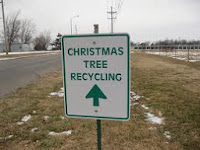
After the holidays, don’t throw your real Christmas tree in the trash or set it on the curb. Real Christmas trees are biodegradable, which means they can be easily reused or recycled for mulch and other purposes.
Here are some recycling options and tips on what to do with your tree after the holidays. Every community is different, but in general, you have these options:
The best way to avoid a mess removing your tree is to place a plastic tree bag (available at hardware stores) underneath the stand when you set the tree up. You can hide it with a tree skirt. Then, when the holidays are done, pull the bag up around the tree, stand and all, and carry it outside. Obviously, you will want to remove the stand before recycling the tree. If some needles do scatter inside, it is better to sweep them up; as needles can clog vacuum cleaners.
Take your tree to a drop off recycling center: Most counties have free drop-off locations throughout the county. Usually, you may take up to two trees to a drop-off location at no charge.
Tree recycling/mulching programs: Tree recycling and mulching programs are a fast-growing trend in communities throughout the nation. Check with your local department of public works for information. They chip and shred the trees, then make the mulch available for use in your garden. Your hauler will notify you of pick-up dates in your area. Be sure to check with your local hauler.
Other Recycling Options
Fish feeders: Sunk into private fish ponds, trees make an excellent refuge and feeding area for fish.
Mulch: A Christmas tree is biodegradable; its branches may be removed, chipped, and used as mulch in the garden. If you have a neighbor with a chipper, see if he will chip it for you.
Living, rooted trees: Of course, next year, you could get a rooted (ball and burlap or containerized) tree and then plant it in your yard after Christmas. (It’s a good idea to pre-dig the hole in the late fall while the soil is still soft, then plant the tree into that hole immediately after Christmas.) Living trees have a better survival rate in mild climates.
